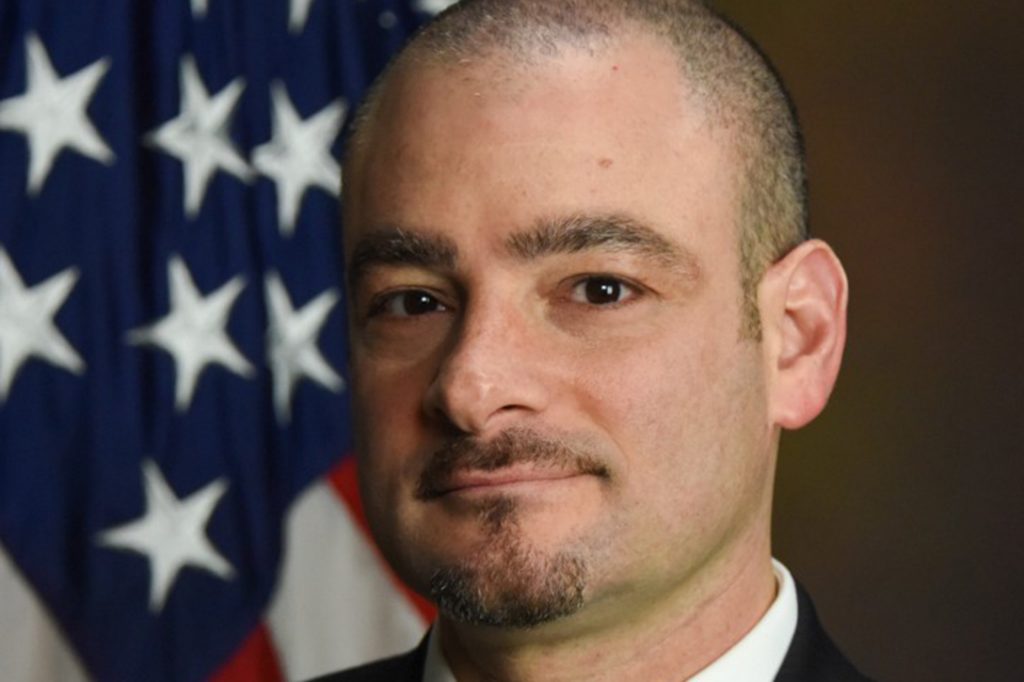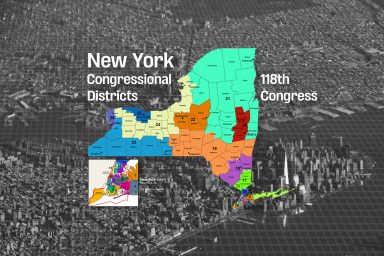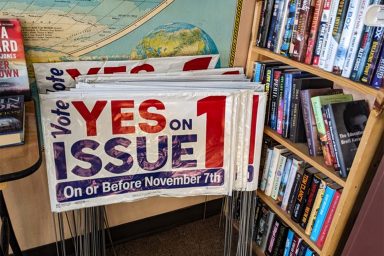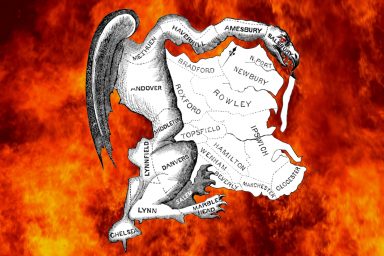What Will/Can the Supreme Court Do about Partisan Gerrymandering?
What You Need to Know about the Upcoming Landmark Decision
The Supreme Court’s upcoming ruling in Gill v. Whitford may be partisan gerrymandering’s most significant legal battle yet. Law professor Justin Levitt discusses why it matters, how we got here, and what we should expect.
Until recently, the power of state legislatures to hijack elections went unchallenged. Lawmakers abused their privileged duty to design their own voting districts by employing a discriminatory precision that essentially nullified the voices of countless voters and ensured the party in charge could continue to dominate future elections.
However, those days may soon be behind us as the Supreme Court prepares to issue its decision in Gill v. Whitford, which could help tame rampant partisan rigging of district maps.
Prior to Gill, governing bodies had long struggled to reach a consensus on how to test whether lawmakers had engaged in unconstitutional partisan gerrymandering. But thanks to the availability of new statistical analyses, it is now possible to determine exactly how many seats were swung to one side of the aisle or another as a result of gerrymandering.
Soon, the nation’s highest court will not only determine if a Wisconsin court was correct in deciding that state Republicans committed the unconstitutional sin; experts expect this decision to also determine which entities should be making these judgments in the first place.
This could have massive implications on how legislators map out their congressional districts, and may finally liberate Americans from this manipulative, partisan weaponry, bringing us one step closer to representatives actually serving constituents and not their own interests and that of their donors.
WhoWhatWhy spoke with Justin Levitt, law professor and associate dean of the Loyola Law School, whose website All About Redistricting tracks the drawing of electoral district lines all around the country. Levitt spells out the implications of this landmark case, as well the historical context that brought us to this decision point.
Where necessary, this interview has been edited and re-arranged for the sake of brevity and clarity.
Considering racial gerrymandering was, for the most part, deemed unacceptable a while back, can you explain why partisan gerrymandering has been allowed to persist up until this case?
The short version is that the courts have been pretty leery of stepping into something as deeply political and partisan as redistricting; it was only in the ‘60s that the courts decided to get into business at all.
And that was really only in situations where race was the primary factor in gerrymandering, right? I guess I’m trying to understand why the courts were willing to address the racial component, but not the partisan one?
In some ways, racial strife is one of the sins of the original Constitution, and we’ve been trying to exorcise it since, so it’s not particularly surprising that the courts would be particularly sensitive around racial matters. We had a doctrine about racial discrimination out of the Fourteenth Amendment for almost a hundred years before we had doctrines about gender discrimination — in part because the racial problems were recognized as bigger, sooner; [and] in part because slavery is unlike any other institution there was.
So what’s changed? Why are we now suddenly seeing this reversal of the courts’ reluctance to address partisan gerrymandering?
I don’t know that it’s “suddenly”, and I don’t know that that reluctance has changed. Part of the reason [the] court is taking this case is to decide whether it’s reluctant.
It’s rare, but there are some things that may be unconstitutional, but it’s not for the courts to decide when [they violate the Constitution]. Those decisions are either left up to Congress, or to the president, or other branches [to] fight it out.
So the fight over how much is too much, and who should decide, has been the fight for hundreds of years.
If you look back at the last time the court engaged this issue, which was 2004, the decision is really a good microcosm of the debate, and it’s a good way to set up what may be coming.
Can you elaborate on that?
The debate in 2004 was a case out of Pennsylvania called Vieth v. Jubelirerand; there was an allegation that the Pennsylvania legislature had gerrymandered on partisan lines. All nine justices agreed that too much partisanship in the redistricting process was unconstitutional, but they had vigorous disagreements over how you know how much is too much, and who should decide how much is too much.
And there are still strains of all of those [2004 viewpoints] on the court: I think there are some justices who think the court has no business in this area, there are some who think the court absolutely should be deciding these things and they [believe they] have the right idea about how [to do so], and there are a few who are waffling and trying to figure out whether the ideas other people have proposed are ideas they can sign up for.
So the moment we’re at is another decision point, but I don’t think the basic legal questions have shifted.
How is this situation unique from Vieth?
One of the reasons this is a decision point is because, for the very first time, a lower court decided that lines were drawn as an unconstitutional partisan gerrymander.
A federal court in Wisconsin — a special kind of federal court [with] a different procedure than the norm, [which] means the Supreme Court has to take the case — found that Wisconsin’s state legislature had engaged in unconstitutional partisan gerrymandering, and they think they’ve got a standard for saying why that happened in Wisconsin but doesn’t happen everywhere.
And why is that significant?
The court is only interested in the standard that doesn’t strike down every map in the country, so the federal court in Wisconsin thinks it found a standard that separates the Wisconsin map from other maps.
And the Supreme Court isn’t just gonna [agree or disagree]; it will want to explain why it agrees or disagrees at great length, and that means that we’re gonna get a decision by some time early next year that explains a lot more about what the current justices think about figuring how much is too much and figuring out whether the court should be involved.
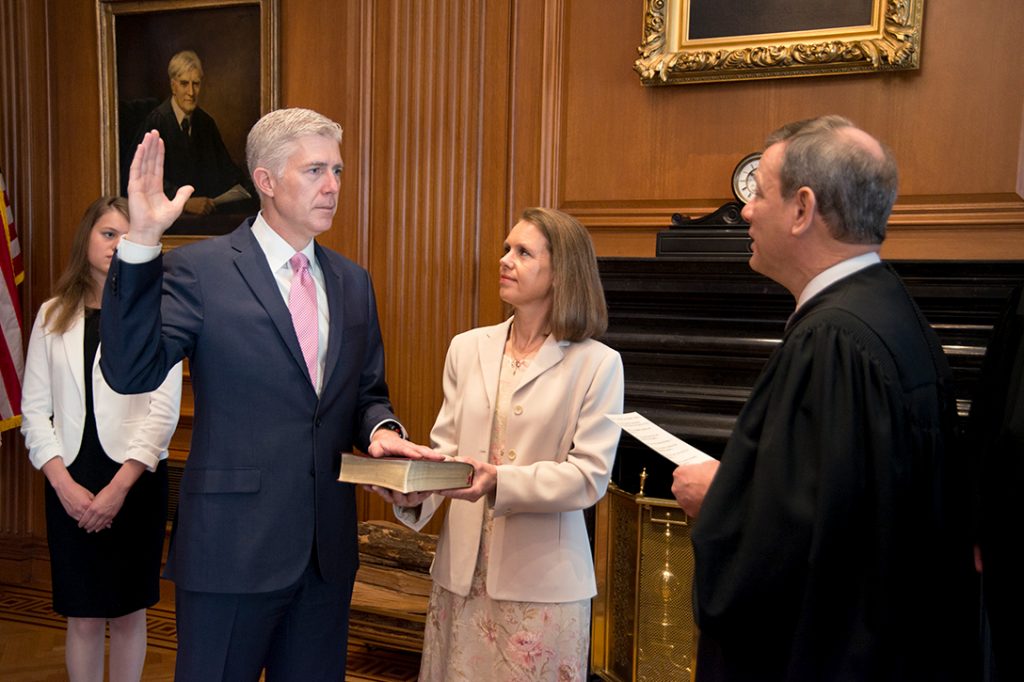
President Trump’s Supreme Court nominee, Neil Gorsuch, was sworn in as the 113th Supreme Court justice by Chief Justice John Roberts. Photo credit: Fred Schilling / US Supreme Court
So now that we have Justice Gorsuch on the bench — a guy who’s kind of a wildcard, in that he doesn’t have a track record with the Supreme Court to infer from — do you have any predictions for how he might lean on this decision?
I don’t, in part because this isn’t a very reliable textual/non-textual, liberal or conservative issue. The Democrats are furious at the Republicans in Wisconsin and North Carolina and a bunch of other states; the Republicans are furious at the Democrats in Maryland and Illinois and a few other states. It turns out that, the vast majority of the time, the party in power looks for ways to mess with the party that’s not in power, and that means that this could actually be a bipartisan issue.
I mentioned that 2004 was the last time that the court really looked at this issue in great detail, and we’ve had five new justices since then, so not only do I not know what Justice Gorsuch thinks about this issue — I don’t know what Justice Kagan thinks about it, I don’t know what Justice Sotomayor thinks about it; I don’t know what a lot of justices think about it.
We got a clue when the Supreme Court decided to grant a stay — to press pause — on the trial court’s request that Wisconsin get to redraw the lines. Four justices — the more liberal four: Ginsberg, Breyer, Kagan, and Sotomayor — said that they would have denied request for stay. That’s a pretty good indication that they thought that there was some merit in the lower court’s decision [that] this was a partisan gerrymander.
The five other votes are a little harder to figure out. They could mean that those five justices don’t think there was merit in the Wisconsin court’s decision. They could [also] mean [they were] not sure whether there was merit and [they didn’t] want to force the legislature to go do a bunch of extra work when [they were] not sure.
They could mean [that since] everybody’s going to have to redraw the lines after the next census in 2021 anyway, so we don’t have to rush to start redrawing. [The five Justices] might well all think there’s a partisan gerrymander here, but [they] can basically make that a rule for the future.
If the Supreme Court does shut down partisan gerrymandering as unconstitutional, will legislators still have any avenues to create unfair partisan advantages through redistricting?
Oh, sure. The fact that there’s a case to be made for some extreme partisanship doesn’t meant that you’ll be able to prove every case, and doesn’t mean that more minor versions aren’t going to fly under the radar.
If the court decides to step into the partisan gerrymandering realm, it’s probably going to act to cut off the excesses, and maybe just some of the excesses, but it is unlikely to fashion a test strong enough to get at all sort[s] of improper or distasteful partisanship in the process.
But the fact that the Supreme Court won’t fix all the problems in politics — and that even if it steps in, won’t fix everything where it steps in — isn’t reason to be upset or discouraged, or to think what the Supreme Court does isn’t useful. Cutting off the extremes makes a big difference, even if it doesn’t fix everything, and there are lots of ways to make that point.
If you’re dealing with gun violence, you don’t have to stop every shooting to realize that stopping really bad mass shootings makes a giant difference.
If you’re talking about healthcare, it’s widely known that healthcare system’s costs are driven in the extreme by a relatively small number of cases of extreme medical need and, therefore, extreme medical cost. If we could figure how to address the most expensive, difficult cases, that would still be a huge step forward, even if that didn’t [make] everybody perfectly healthy all the time.
So I don’t want to convey that even a relatively modest step in this area is not important. It is. And perhaps it’s most important in establishing a principle of what legislators should or should not be doing, even if we can’t police that perfectly all the time. The principle itself is important.
So if a Supreme Court decision isn’t gerrymandering’s silver bullet, what is?
As long as legislators are in charge of drawing their own district lines and have that very inherent, very understandable conflict of interest, they will try to use rules that exist to their own advantage. If I had control over whether I had a job next year or not, I’d have a job next year — that’s very natural, and nobody should be surprised by it.
There are a few states that have taken steps to further limit that conflict of interest by taking the power to draw district lines away from the people who stand to benefit most by them, but that hasn’t happened everywhere, and it’s not particularly realistic everywhere. Most of the places [where] that has happened have been states that have citizens ballot initiatives, and not every state allows that.
Along those lines, the idea of implementing independent redistricting commissions sounds like a wise way forward, don’t you think?
I think it is wise where it’s feasible, yes. I don’t think any state has one, perfect version that I [would] carbon copy [across the country].
What makes a districting protocol appropriate for one state but not others?
California is big and a little more complicated and has a very different structure [that], in many ways, reflects the politics and demography of California. Idaho is smaller and leaner and independent, but doesn’t have quite as many complications to worry about, either in the process or the rules they apply, and that’s because Idaho’s political demography may be a little bit simpler.
An awful lot has to do with the political culture of any given state. There’s a system in Iowa that works beautifully in Iowa, [which] essentially exists because the legislature lets it exist; it is entirely a creature of statute. The legislature hasn’t ever stopped the commission because in Iowa’s political culture, the commission’s not something you mess with. I don’t know that that would work anywhere other than Iowa, but it works really well in Iowa.
What’s unique about Iowa that allows that sort of political culture to exist in the first place?
Part of it is just how Iowans think about doing business, [and] part of it is that the choices in Iowa are a little bit easier because of the political demography: Iowa’s not homogenous, but it has similar mixes of diverse people all around the state, so it’s not that Iowa looks all the same, but Iowa looks different or diverse in ways that are similarly spread throughout the state. It doesn’t have one big anchor city and a bunch of little rural places; it’s got a few small towns and lots of ex-urban areas.
So perhaps it’s some blend of an innate political culture and the fact that where you draw the lines matters a little bit less in Iowa than it does in other places because you end up with about the same configuration of the districts any which way.
There are cultures that have built up in various areas of the country that are just different from each other, and I don’t know that there’s an explanation for it other than historical; it’s the way things have been, and it’s the way people like it.
Data from the Census plays a big role in drawing these district maps. Are you concerned about the 2020 Census, in light of the director stepping down following the Bureau’s complaints about inadequate funding?
Very. The inadequate funding is a big concern; there are operational risks, and the funding risks make that worse. The census is not something we should be messing with.
It is, I think, the second or third sentence in the Constitution — I mean, once you get past the preamble, you dive pretty quickly into: “There’s a House of Representative, and we take a census.” So it’s right there at the core of the document.
Because since we’ve had a Census [beginning in] 1790, it has been the way that we know where the people are — not only for an economic engine, or to get a sense of demographics, but for representational purposes. And if the census doesn’t go right, it can have really far-reaching consequences to representation — ones that are virtually impossible to correct for until you get the next census, ten years over.
States with populations that are hard to count have a big incentive to make sure the census does its work really well — not only for policy reasons, but because the higher your census numbers, the more congressional seats you get. And there are lots of states, both red and blue, with populations that are hard to count, so it’s not like there’s a reliable liberal, conservative [division].
One of the states projected to grow the most is Texas, so Texas stands to gain between three and four congressional seats if growth continues as it has, but for representational purposes, it only grows if the Census counts people there.
So I think it should be disturbing to everyone, and on a bipartisan basis, if the Census Bureau’s difficulties are causing it to have operational difficulties. I don’t know that we’ve got a handle on how that particularly cuts, or which party that benefits or which party that hurts.
Gerrymandering is often portrayed as a Republican-instigated issue — is that a fair characterization, or is the Left guilty, as well?
No — it is a deeply partisan issue, but which party you get angry at depends on where you are: if you ask folks in North Carolina, it’s the Democrats who are furious. If you travel just up the coast to Maryland, it’s the Republicans. So I don’t actually think that this is a Democratic issue or Republican issue.
I think that right now, there is more [general] concern over partisan gerrymandering that Republicans did because Republicans had unilateral control of far more seats in 2010. I can promise you that whoever has more control over more seats in 2020, the other party will think it’s a big deal.
If, for example, Democrats are controlling the drawing of district lines in 2020, you will see Republicans just as upset.
Some are saying Republicans have locked up congressional seats for the remainder of the decade as a result of their gerrymandering. Do you agree?
No, they built a rather formidable sea wall. Certainly, at the moment, the Democrats are laboring uphill. For what it’s worth, they’ll be laboring uphill whether or not the Supreme Court decides this case, because it’s exceedingly unlikely that the district structure will change dramatically in 2018, outside of a very few states. [But] you need a crystal ball to know who’s going to have unilateral control in 2020.
In 2010, there was a Republican wave. One normally expects [that wave] to come in and then recede, and then come in and then recede. There’s a cyclical pattern to most politics, and because the wave came in 2010, Republicans were put in charge of drawing the lines in many states, and they were able to erect a rather formidable sea wall so that the wave didn’t recede quite as much or quite as fast, and it meant the sort of normal ebb and flow didn’t affect quite as much as it would have otherwise. But a big wave election can come over a seawall. Then you could see control shift.
Is there any final message you’d like to leave us with before we wrap this up?
The one thing [there is] bipartisan agreement on is that we should do something about infrastructure, because people don’t think about it, but it matters a ton. They expect the roads to work, the bridges to work, the sewers, the electrical grid, the Internet to work. And as long as it works, nobody pays attention to it. And when it breaks down, it breaks down in pretty spectacular ways, and then people get very, very, very angry.
Redistricting and district lines are the infrastructure of democracy, which means they’re how we do everything else. It doesn’t matter what policy you are concerned about — whether it’s local, state-based or national — because the district lines drive how we elect our representatives and which voices are heard, [and] they drive everything else.
So this issue is the infrastructure for the infrastructure, and thank you for doing this story. I would hope that people pay as much attention to it outside of the big elections as they do to the actual election process. People tend not to care about this outside of an election season. So if there is one thing you’re communicating to folks, it’s that this is infrastructure week all the time.
The fact that people are thinking about it now and getting ready for, not only this court case, but the upcoming Census and the upcoming round of redrawing, I think is a really good sign. I would hope that more people were more engaged on the issue.
Related front page panorama photo credit: Adapted by WhoWhatWhy from President Trump visits the US Supreme Court (Fred Schilling / US Supreme Court).

